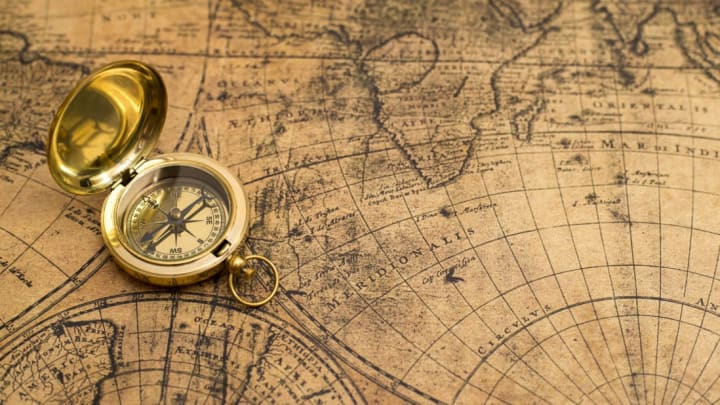Between the 15th and 17th centuries, European sailors traversed the globe in search of riches, glory, and new trade routes. Historians refer to this period as the Age of Exploration, or the Age of Discovery. The voyages of Christopher Columbus and others may seem like ancient history, but they actually resulted in major cultural exchanges that shaped the world we live in today, in ways both big and small—and not always for the better, as you’ll see on National Geographic’s Origins (Mondays, 9/8 CST). Here are five lesser-known ways their overseas exploration molded modern civilization:
1. IT PAVED THE WAY FOR THE MODERN-DAY AMERICAN COWBOY.
Long before Western cowboys and their trusty steeds herded cattle, there weren’t any horses or cows in the Americas. But in 1492, Columbus established a settlement on the Caribbean island of Hispaniola. The following year, the explorer returned to the island, and brought longhorn cattle and horses with him.
Soon after, in 1519, Spanish explorer Hernán Cortés and his soldiers arrived in what’s today called Mexico, their sights set on conquering the wealthy Aztec empire. They, too, brought horses and the Spanish eventually established ranches and imported cattle to Mexico and the Caribbean. These animals eventually made their way to the present-day United States, paving the way for westward expansion and—yes—the emergence of the American cowboy.
2. IT REDEFINED WHAT IT MEANT TO BE WEALTHY.
The influx of gold and silver from the New World shook the foundations of the European economy to its core. Where land ownership—and the rents charged by landowners—once determined wealth, the arrival of large quantities of gold and silver, both of which had formerly been in short supply, caused prices to skyrocket. This dramatic shift is what historians refer to as “The Price Revolution”: Landlords on fixed incomes suffered as the value of their incomes dropped and the debts owed to them also shrank. Trade soon replaced land-ownership as the most expedient way to achieve wealth.
3. IT TURNED THE WORLD ON TO TOBACCO.
For better or worse, the Age of Exploration introduced modern European civilization to the practice of smoking. When Columbus arrived in the Bahamas in 1492, residents of the island of San Salvador gave the explorer a gift of dry tobacco leaves. Columbus didn’t understand their purpose, and threw them overboard. Later, he’d write that the locals “drank smoke.” Soon after, Columbus and his expedition arrived in Cuba, where locals also practiced the curious custom. Two members tried it for themselves, and reportedly became hooked.
In subsequent years, other European explorers encountered tobacco, and in the 1550s, tobacco seeds arrived in Spain and Portugal. Europeans used the leaf for medicinal purposes—and eventually, recreational ones. Meanwhile, the Spanish fed Europe’s cravings by cultivating the leaf; they controlled the tobacco trade until the 17th century, when John Rolfe of the Virginia Colony first shipped tobacco to England.
4. IT GAVE SOME COUNTRIES THEIR SIGNATURE FLAVORS …
This may shock some people, but the potato isn’t native to Ireland, the tomato hasn’t always grown in Italy, and the chili is a relatively modern addition to Asian and Indian dishes. But thanks to European explorers, these crops made their way across the world, took root in foreign soil, and became an indelible part of the regional cuisine.
Sixteenth century Spanish conquistadors discovered the potato in Peru and took it back to Europe. It became a staple food on Spanish ships, and spread across the continent; eventually, Sir Walter Raleigh brought the potato to Ireland in 1589. In coming centuries, the potato would become an essential food source. During the 19th century, the nation’s poorer classes ate up to 19 potatoes a day, according to one estimate.
Meanwhile, the tomato is native to the Andes of South America, Mexico, and Mesoamerica; it, too, was brought to Europe by the Spanish conquistadors. Europeans initially believed the tomato was poisonous (the acidic fruits soaked up the lead in pewter plates), but they eventually realized the error of their ways. The Spanish taught Italians how to cook with the tomato, and by the late 18th century, they were transforming it into sauces and pastes.
And Columbus is credited with introducing the chili pepper—which is native to the Caribbean and South America—to Europe. From there, traders brought the spicy fruits to West Africa, India, and East Asia. Today, it’s hard to imagine how Thai or Indian food would taste without chili peppers.
5. … AND GAVE THE REST OF THE WORLD A TASTE FOR CHOCOLATE.
Columbus may have been the first person to bring cacao beans—which chocolate is made from— to Europe, following his fourth voyage to the Americas in 1504. However, it’s commonly believed that Cortés was the first European to sample the beans, which the Aztecs introduced to him in the form of a bitter drink. Cortés introduced cacao beans and brewing methods to Spain; Europeans mixed honey or sugar with the resulting beverage, making it a sweet—and popular—treat. The drink soon caught on in other countries, setting the stage for our global obsession with all things chocolate.
